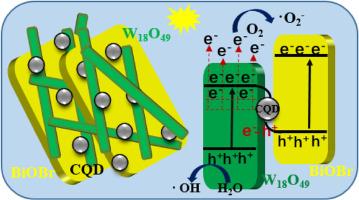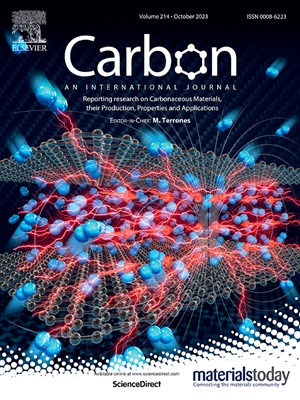Improving photoexcited carrier separation through Z-scheme W18O49/BiOBr heterostructure coupling carbon quantum dots for efficient photoelectric response and tetracycline photodegradation
IF 10.5
2区 材料科学
Q1 CHEMISTRY, PHYSICAL
引用次数: 0
Abstract
Building Z-scheme heterostructure integrating oxygen vacancies seems to effectively encourage photoexcited charge partition and hence photoelectric response and photocatalytic performance. Here, through the inclusion of carbon quantum dots (CQDs) with W18O49/BiOBr (WB) for enhancing electron exchange and band structure control, we have developed one Z-scheme ternary CQD/W18O49/BiOBr heterostructures (CWB) with intense oxygen vacancies. The optimal CWB heterostructure shows superior photocatalytic and photoelectric response execution. The findings indicate that CWB has higher photocatalytic degradation efficiency of tetracycline hydrochloride (TC) at 97 % compared to WB or W18O49 alone. Additionally, the CWB shows a higher photocurrent density, surpassing WB and W18O49 by 2.5 times and 5.4 times. A potential self-supplied photoelectrochemical-type photodetector utilizing CWB displays relatively quick and stable photoelectric response at 0 V. The improved photo-electric performance are linked to the combined impact of separation and redistribution of charges caused by Z-scheme heterostructure and oxygen vacancies, as well as intensive light absorbance by localized surface plasmon resonance. Our research also validates significance of CQDs as cocatalyst in accelerating the splitting of photo carriers in Z-scheme ternary CWB heterostructures, which will stimulate interest in creating advanced photoactive heterojunction substance with carbon nanomaterials.

通过 Z 型 W18O49/BiOBr 异质结构耦合碳量子点改善光激发载流子分离,实现高效光电响应和四环素光降解
构建集成氧空位的 Z 型异质结构似乎能有效促进光激发电荷分离,从而提高光电响应和光催化性能。在此,我们通过将碳量子点(CQDs)与 W18O49/BiOBr(WB)结合以增强电子交换和能带结构控制,开发了一种具有高氧空位的 Z 型三元 CQD/W18O49/BiOBr 异质结构(CWB)。最佳的 CWB 异质结构显示出卓越的光催化和光电响应执行能力。研究结果表明,与单独的 WB 或 W18O49 相比,CWB 对盐酸四环素(TC)的光催化降解效率高达 97%。此外,CWB 显示出更高的光电流密度,分别是 WB 和 W18O49 的 2.5 倍和 5.4 倍。光电性能的提高与 Z 型异质结构和氧空位导致的电荷分离和再分布以及局部表面等离子体共振产生的强光吸收的综合影响有关。我们的研究还验证了 CQDs 作为协同催化剂在 Z 型三元 CWB 异质结构中加速光载流子分裂的重要意义,这将激发人们对利用碳纳米材料创造先进的光活性异质结物质的兴趣。
本文章由计算机程序翻译,如有差异,请以英文原文为准。
求助全文
约1分钟内获得全文
求助全文
来源期刊

Carbon
工程技术-材料科学:综合
CiteScore
20.80
自引率
7.30%
发文量
0
审稿时长
23 days
期刊介绍:
The journal Carbon is an international multidisciplinary forum for communicating scientific advances in the field of carbon materials. It reports new findings related to the formation, structure, properties, behaviors, and technological applications of carbons. Carbons are a broad class of ordered or disordered solid phases composed primarily of elemental carbon, including but not limited to carbon black, carbon fibers and filaments, carbon nanotubes, diamond and diamond-like carbon, fullerenes, glassy carbon, graphite, graphene, graphene-oxide, porous carbons, pyrolytic carbon, and other sp2 and non-sp2 hybridized carbon systems. Carbon is the companion title to the open access journal Carbon Trends. Relevant application areas for carbon materials include biology and medicine, catalysis, electronic, optoelectronic, spintronic, high-frequency, and photonic devices, energy storage and conversion systems, environmental applications and water treatment, smart materials and systems, and structural and thermal applications.
 求助内容:
求助内容: 应助结果提醒方式:
应助结果提醒方式:


